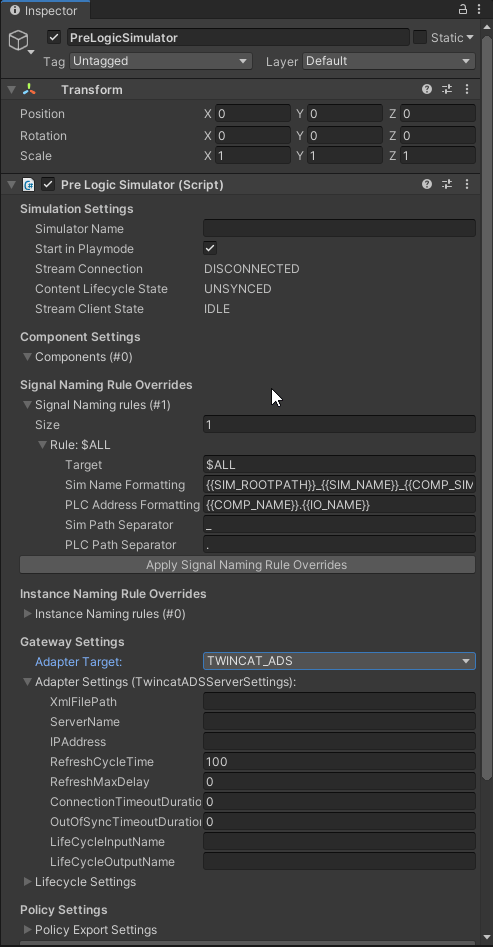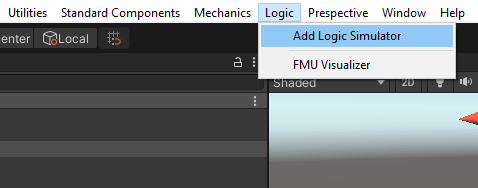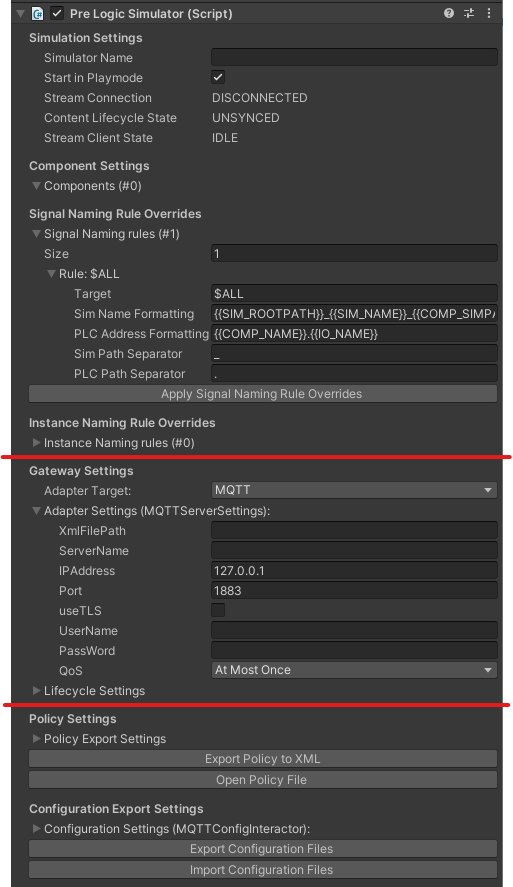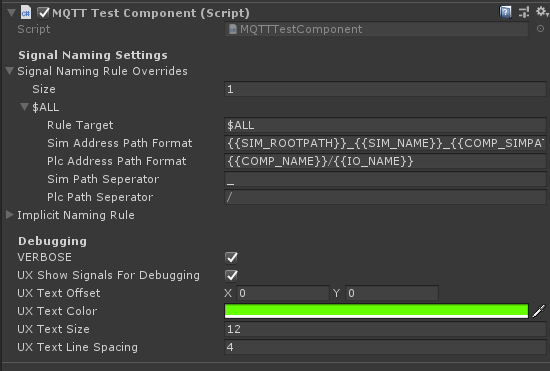As with all adapters, an existing https://unit040.atlassian.net/wiki/spaces/PUD/pages/280987237/Logic+Simulator#Overview is required.

Where to find the different Gateway Adapters.
To find the MQTT adapter, go to the Inspector window of a https://unit040.atlassian.net/wiki/spaces/PUD/pages/280987237/Logic+Simulator#Overview component.
This https://unit040.atlassian.net/wiki/spaces/PUD/pages/280987237/Logic+Simulator#Overview can be added under Logic.


Only the settings between the lines refer to the MQTT Adapter. |
Please check the documentation for the rest of the https://unit040.atlassian.net/wiki/spaces/PUD/pages/280987237/Logic+Simulator#Overview
Gateway settings | ||
|---|---|---|
Adapter Target | Select a different adapter, please see respective documentation for more information | |
Adapter Setting (MQTTServerSettings) | ||
XmlFilePath | File path to the policy file
| |
ServerName | Is used as the an indicator in the XML policy file | |
IP Address | The address of the MQTT broker. This can be a be in IPv4 address or a hostname like localhost | |
Port | The port on which the MQTT broker is running, | |
use TLS | Should be turned on when the broker is using TLS authentication. (off by default)
| |
UserName | Is passed to the server for authentication if the field is not empty (not used by default) | |
PassWord | Is passed to the server for authentication when the UserName field is not empty (not used by default) | |
QoS | (Quality Of Server) is an agreement between the broker and client that defines the guarantee of delivering a message: 0 : At most once => There is acknowledgement between broker and client other than regular TCP , fast, unreliable (packet loss)) 1 : At least once => The sender buffers the value until a ‘PUBACK’ is returned by the broker. Message can be sent multiple times (, slower, reliable) 2 : Exactly once => The sender sends the message, the broker returns a ‘PUBREC’. The sender is returning a ‘PUBREL’ and the server again returns a ‘PUBCOMP’ command to finalize the sending process. (slow, very reliable)
| |
Lifecycle settings |
|
QoS (Quality of Server) - Detailed agreements
QoS | known as | speed | reliability | remarks |
|---|---|---|---|---|
0 | fire & forget | fast | poor | Messages can get lost in unstable connections. Very suitable for wires local connection |
1 | single handshake | slower | good | No message is lost. Can lead to duplicate messages. but is much faster than QoS 2 |
2 | double handshake | slowest | exact | If getting the message exactly once is more important than performance. Quite an overhead compared to the other 2 levels |
Please see the https://unit040.atlassian.net/wiki/spaces/PUD/pages/280987237/Logic+Simulator#Overview documentation for further instructions on setting up your simulation.
MQTT can work with an online broker, but is more commonly used with a local broker. There are a lot of brokers available. An overview can be found at: https://en.wikipedia.org/wiki/Comparison_of_MQTT_implementations
ActiveMQ also has an MQTT broker when installed, but feel free to choose one to your liking.
For testing purposes we recommend using a client like i.e. MQTT.fx https://mqttfx.jensd.de/
To communicate with the MQTT adapter in Prespective you need to apply the following protocol:
The structure for the message is:
<PLCADDRESS/<VALUE>
Topic to write is the address defined by the PLC address in the signal naming
Value is the value that is within the range of the specified type
BOOL
BYTE
SBYTE
WORD
DWORD
SHORT
USHORT
INT16
UINT16
INT32
UINT32
INT64
UINT64
REAL32
REAL64
BYTEARRAY
STRING
STRUCT

Setting up the component works as like any other prelogic component. The thing you have to take into account is how the PLC Address Path Format (or implicit naming rule) is configured. The output of this Address is the topic to which the component is reading and/or writing.
WARNING : < Make sure both paths are unique > |
Each defined input writes the value to the PLC address path topic.
Each defined output reads the value from the PLC address path topic.
The PLC path separator has to be '/'
< Spaces are allowed but not recommended > |
A leading '/' is not recommended because it leads to an extra parent topic with id 0. |
For an overview of all variables for signal naming, please go to the prelogic component page.